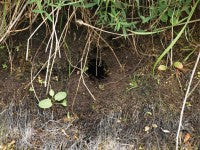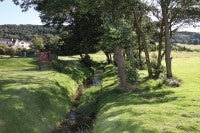A vole in one!
 Water voles are a recent addition to the UK's list of protected species and can be seen along ditches, canals, rivers and ponds throughout mainland Britain. This furry little brown mammal, commonly known as the 'water rat' (ratty in Wind in the Willows) is the largest of the voles found in Britain and is part of the rodent family.
Water voles are a recent addition to the UK's list of protected species and can be seen along ditches, canals, rivers and ponds throughout mainland Britain. This furry little brown mammal, commonly known as the 'water rat' (ratty in Wind in the Willows) is the largest of the voles found in Britain and is part of the rodent family.
There are two species of water vole found in the world; the northern water vole, which is found in Britain, Europe and Russia, and the southern water vole only found in the south west of Europe.
Water vole decline and protection
Water voles have suffered a long term population decline within Britain since 1900. Once they were widespread all over mainland Britain, but now they are scarcely populated, with higher populations in the South and East, as well as North Wales and the Peak District. This decline is due to changes in land use and riparian land management leading to habitat loss, which has caused populations to become isolated, preventing the voles from breeding outside their colony and spreading out. Isolation also leaves the water voles vulnerable to predation, as there is not as much vegetation to hide in.
Water voles were first protected under law in 1998, under Schedule 5 of the Wildlife and Countryside Act 1981, and revised under the later Countryside and Rights of Way Act 2000 and the Nature Conservation Act 2004 in Scotland.
 Initially, water voles were only protected under section 9(4) which does not protect the water vole itself being harmed, but their place of breeding, shelter or protection (i.e. to intentionally or recklessly damage, destroy or obstruct any structure used for breeding or shelter).
Initially, water voles were only protected under section 9(4) which does not protect the water vole itself being harmed, but their place of breeding, shelter or protection (i.e. to intentionally or recklessly damage, destroy or obstruct any structure used for breeding or shelter).
In 2008, this level of protection was increased to make it illegal to deliberately capture, injure or kill them. Licences can be issued by Natural England for allowing prohibited actions against water voles such as conservation, education, to prevent disease, prevent loss of livestock/crops and for public safety issues. In terms of development sites with water voles, licences are not required; however, companies are required to take appropriate action to prevent breaking the law (i.e. destroying habitat). If a developer has seen to be neglectful, they can be prosecuted.
The life of a water vole
Water voles live in burrows and form colonies alongside rivers, streams, ditches and lakes. As the habitat they occupy is often linear, e.g. rivers, they will string themselves out along the waterside, forming ranges. Each vole will occupy a series of burrows. There are different types of burrows serving different purposes. A residential burrow is made up of several entrances with interconnecting tunnels with a food storage area and nest chambers. The second type of burrow is called a bolt-hole, which is a basic tunnel ending in a single chamber, these are used as resting and hiding places when voles are out feeding.
 The water vole's diet consists mainly of waterside plants, making them herbivores. They eat the aerial stems and leaves of over 200 species of plants, a favourite being common reed. Over the winter period, when most vegetation dies, water voles will survive on the roots and bark of woody species, like willow, and the bulbs and roots of herbaceous plants. During autumn, they will hunt the fruit and seeds from any plant/tree species. These vegetation preferences, to some extent, dictate the habitat preferences.
The water vole's diet consists mainly of waterside plants, making them herbivores. They eat the aerial stems and leaves of over 200 species of plants, a favourite being common reed. Over the winter period, when most vegetation dies, water voles will survive on the roots and bark of woody species, like willow, and the bulbs and roots of herbaceous plants. During autumn, they will hunt the fruit and seeds from any plant/tree species. These vegetation preferences, to some extent, dictate the habitat preferences.
They prefer water courses that are flanked by water borne plants that grow in the water and the banks, providing shelter and food. Other factors effecting habitat preference are slow flowing deep water and soft banks making it easier to dig burrows.
Breeding females will form territories and share their burrows with their female offspring. Males will form ranges that overlap with the females and other males, and the males will compete with each other for access to the females. A female will mark her territory with droppings and scent, which will then be counter marked by a male when he has chosen or fought for that female.
A female water vole produces 2-5 litters annually during the breeding season, which runs from March to October. Each litter can have from five to eight young; those born early in the year may reproduce the same year, but most will mature to breeding status the following year.
The natural life expectancy of water voles is very short, at two to three years. However, water voles can suffer large predation rates, which decrease life expectancy to fewer than two winters. The winter months can affect a vole population if there is a particularly cold winter or a bad summer/autumn; particularly if the juvenile voles have not gained enough weight to survive a harsh winter as plants die-back. Water voles do not hibernate, but they will spend most of the winter in the nest chambers, sharing with other voles to keep warm.
Predators and pollution
Water voles are predated upon by a number of other animals. Their main predator is the American mink, which was brought to the UK in the 1920s for fur farming. However, over the years, some of the mink escaped and a wild population has subsequently formed in Britain. American Mink are very efficient at hunting water voles because they can swim after the voles, with the females being small enough to follow voles into their burrows, taking adults and young.
 Other predators are bigger carnivorous mammals, such as stoats and weasels, whilst birds of prey, such as kestrels and barn owls, are also a threat.
Other predators are bigger carnivorous mammals, such as stoats and weasels, whilst birds of prey, such as kestrels and barn owls, are also a threat.
As well as being affected by habitat destruction and predators, water voles can also be affected by water levels. Drainage of nearby land for flood control will impact on water voles as the fluctuating levels may destroy their food stores and flood their nest burrows. The opposite negative impact to flooding is drought, which can completely dry out a watercourse, exposing the voles to land predators.
As well as predation and natural causes, water voles are also highly susceptible to water pollution, especially habituated water courses that border farmland. Waste products can end up in the surface run-off water from the farm and pollute the water, affecting the breeding success of the water voles. This issue may have been one of the key reasons for the mass decline of water voles in the 20th Century. However, modern legislation has helped improve the quality of the British waterways in recent years. Water voles may also be impacted by efforts to control pest rodents, like rats and rabbits, by eating poison left out.
Water voles and golf courses
Golf courses can provide the ideal environment for water voles. Many golf courses have water bodies, whether it is a pond or a small lake or manicured ditches, all providing exciting features for the most avid of golf players. These water features also provide excellent habitat for the water vole. A nice steep sided bank, which is profiled and filled with water plants, provides not only ideal shelter but ideal food at meal times. 
Water voles have the ability to live in close proximity to humans and don't seem to suffer from disturbance, which puts them in good stead, as most predators will be put off by the golfers on a golf course.
Currently, the Ayrshire Rivers Trust is undergoing a water vole release project where they are dedicated to improving the water vole population in Ayrshire. During 2010, they are to set up two release sites, both of which are at municipal golf courses. The golf courses have burns, which have, historically, held water voles but, for various reasons, are no longer present. The burns provide a perfect habitat for the voles, with running water and vegetated banks, steep enough for voles to burrow into.
The management of the burns had to be changed slightly to provide ideal vegetation, which has involved allowing the grass to grow a bit wilder and the planting of some new plant species to provide food for the voles. This hasn't had a major impact on the golf courses and has also provided the water-way with some attractive flowers, keeping the golf course presentable and allowing everyone to be a winner.
 Field signs: if you want to look for water voles whilst out playing golf, or just in general when out walking, it is quite easy. Along water courses, look along the banks for small holes indicating burrows. These will be about the size of a small fist and usually, if you can see below the water, there'll be a hole below the water line as well as above.
Field signs: if you want to look for water voles whilst out playing golf, or just in general when out walking, it is quite easy. Along water courses, look along the banks for small holes indicating burrows. These will be about the size of a small fist and usually, if you can see below the water, there'll be a hole below the water line as well as above.
Latrines are also an easy visible field sign, these are piles of water vole droppings along the bank, usually just at the waters edge. Water voles also create food stores which are called feeding stations. These are bits of cut vegetation stacked up in piles amongst the vegetation at the waters edge and, if you're lucky enough, you may see a vole having his lunch!
Robyn Briggs, Field Ecologist with Peak Ecology Email: robynbriggs@peakecology.co.uk
 Any golf club wishing to initiate a release programme should, in the first instance, talk to their county wildlife trust, who will be able to offer further advice on where breeding and release programmes are being undertaken.
Any golf club wishing to initiate a release programme should, in the first instance, talk to their county wildlife trust, who will be able to offer further advice on where breeding and release programmes are being undertaken.
Derek Gow is one of the foremost authorities on water voles. His consultancy group undertakes the captive breeding, translocation and reintroduction of the species - www.watervoles.com
Natural England has advice on water vole management (www.naturalengland.org.uk) along with downloadable PDFs.
